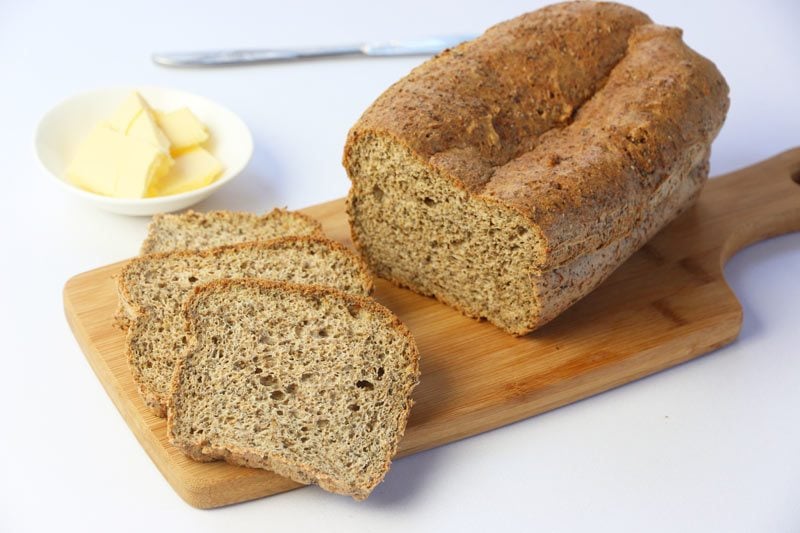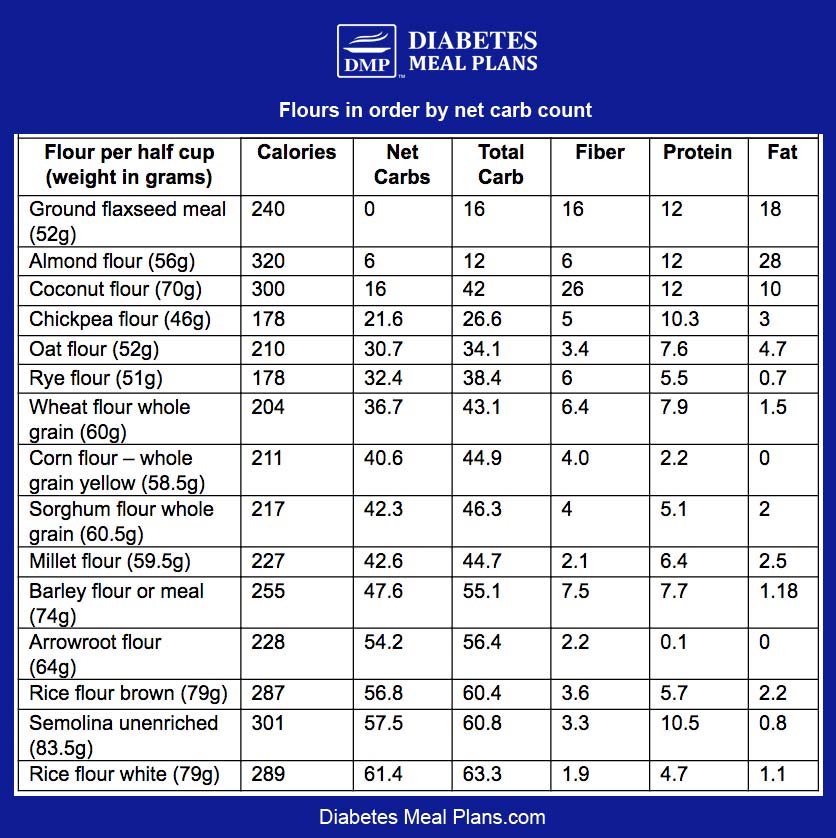
So many questions come up about good ‘ol bread. And not surprisingly because it's a staple food that we've all grown up on. Toast for breakfast, sandwiches for lunch, a side of bread for dinner, it's a pretty common practice, right?
But if you're diabetic, should bread get the cut? Is it okay to eat? Are there certain types of bread that are better than others?
These are all great questions so let's dig in and go over this together now. If you have any questions, just leave them at the bottom of the post and we'll chat about it.
What Kind Of Bread Is Best For A Diabetic?
We've recently covered the types of flours that are best for diabetes, so before we dig in and talk about bread, let's briefly look at the flour cheat sheet.

See how everything above coconut flour goes up from 30 g net carbs and above, which is really getting up there.
In reality, the best breads for you to eat are ones made from flaxseed, almond, chickpea or coconut flour, which are a bit more difficult to come by.
Of course, the simplest way to overcome this is to make your own. But, I understand that not everyone wants to make their own, and thankfully, there are quite a number of companies that supply great low carb bread options you can buy.
Whole Wheat & Rye Bread and Diabetes
It's often recommended that you eat whole grains instead of the white stuff and it's true, whole grains are a better choice because they are complex carbs, rather than simple carbs.
But, when you take the whole grain and grind it into a flour, it changes the way your body digests it. This mainly happens because the bulky fiber component of the grain gets broken down, meaning less digestion – for you as a diabetic that means higher blood sugar spikes.
Have you heard of the glycemic index before?
“The glycemic index (GI) is a ranking of carbohydrates on a scale from 0 to 100 according to the extent to which they raise blood sugar levels after eating.” Source
High GI foods rapidly affect blood sugar, while low GI foods have a slow digestion and absorption and produce a more gradual rise in blood sugar. Below 55 is considered low GI. So the lower a food is the better, and the higher it is the faster it affects blood sugar and the worse it is for you as a diabetic.
So now we can look at the GI of both a whole wheat kernel and whole wheat flour as an example. Whole wheat kernels are 30 (low GI) and whole wheat flour is 71 (high GI).
What this really means is that whole wheat bread really isn't that great.
Your best bet when it comes to rye bread is Pumpernickel bread – it's made from whole rye grains and is a low GI of 41-46. But, pumpernickel bread isn't exactly a sandwich type bread and has it's own pungent flavor, too.
Let's check out some more GI levels:
Normal rye bread 57-78
Wheat whole grain 68-69
Wheat white bread 71
100% wheat white bread 85
So these are all high GI and aren't good options.
Sourdough Bread and Diabetes
Sourdough bread is made by traditional methods, where the starter dough is fermented to provide the rise in the bread instead of yeast and sugar. Surprisingly, this bread making method is much better for us.
Making sourdough produces beneficial gut bacteria that help with digestion, and this has a strong impact on how it then influences the blood sugar response.
As a consequence, sourdough breads are lower in GI – sourdough rye bread 48, 80% barley bread made via sourdough 53-66, sourdough wheat bread 54. So having a slice of sourdough is going to be a better choice than most other breads.
But there is a bit more to the story.
Does Cutting Bread Help Diabetes?
The thing is, GI is important, but then you have to consider your overall carbohydrate intake as well.
Here are some of the above breads with carb quantity:
Pumpernickel bread – 1 slice 26 g = 12.3 g carbs, 1.7 g fiber, 10.6 g net carbs (Total carbs minus fiber = net carbs)
Oat bran bread – 1 slice 30 g = 11.9 g carbs, 1.4 g fiber, 10.5 g net carbs
Buckwheat bread – 1 slice 47 g = 20 g carbs, 2 g fiber, 18 g net carbs
Sourdough wheat bread – 1 slice 57 g = 29 g carbs, 3 g fiber, 26 g net carbs
Sprouted grain bread 1 slice 34 g = 15 g carbs, 3 g fiber, 12 g net carbs
As you can see an average piece of bread is going to be anywhere from 10-20 g carbs.
Please pin or share this info to help others; then keep reading.
One slice of bread is considered one serve, or one carb count and is around 15 g carbs on average. While that's not too bad, if you can keep your carbohydrate intake lower overall each day, you'll be better off for it – meaning, yes, cutting ‘traditional' forms of bread can help diabetes.
This might not be the same opinion that you read elsewhere, or even the guidelines your dietitian might give you. Often they say 30 or 45 g carbs per meal is fine, some of them even recommend up to 70-80 g carbs per meal. But in my experience, (and what the research shows) many diabetics get the best results when they stick to eating that many carbs per day, not per meal.
Eating 50-80 g carbs per day might sound drastic but it is totally possible. And you can still have bread – if it's the right kind.
To answer the question – does cutting bread help diabetes?
Well, if you're cutting the ‘traditional' types of bread, the types you'll find at the supermarket, then yes, the less you consume it, the lower your blood sugar and A1C will be.
Making Low Carb Breads At Home
Baking bread at home is going to be your best option. And it's actually very easy to do – if you know how.
For instance, we have a wholemeal bread where you put all the ingredients into a food processor, blend, pour into a loaf pan and bake. Easy prep, easy cook. And best of all, it's just 1 gram net carbs per slice!
Low Carb Wholemeal Bread – Just 1 Gram Net Carbs!
Since low carb bread uses almond flour, flaxseed meal, coconut flour, and sesame flour, it can be an expensive trial and error because you can't use low carb flours in the same way as you do regular wheat or gluten-free flours.
Another example is our 3 Minute Bun. It is ZERO net carbs and can be loaded with any of your favorite fillings.

3 Minute Microwave Bun – with Various Fillings
Is bread better than cereal for a diabetic?
This is another question that often gets asked and the answer is yes. I'd choose a slice of bread over most breakfast cereals any day because most cereals are way too high in sugar.
Of course, not all breakfast cereals are made alike, but generally speaking, bread will contain fewer carbs, and far less sugar (and salt) than most common breakfast cereals.
Low Carb Bread Options
Low Carb Bread Options
You basically just have to shop around, but as you can see there is low carb bread you can buy to help solve the diabetic bread dilemma!
You can also just live without bread.
Again, cutting out bread may sound extreme but it is possible. And to emphasize the alternatives, making low carb bread at home will be your best option long term – so learn how to do it

No comments:
Post a Comment